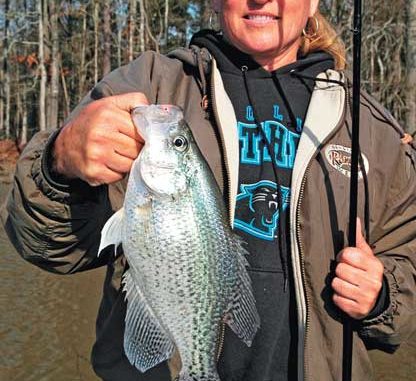
May on Jordan Lake can be as heavenly for crappie fishermen as early spring.
Rhonda Reid glanced over her shoulder at her boyfriend, Jay Garrard, and giggled.
“Hey, you gotta POP IT!” she said from the stern of his boat.
Moments earlier, at the bow, Garrard had turned the air blue with some choice words after missing a fifth-consecutive hookup with a Jordan Lake slab.
“Man, that was a good one,” he said, shaking his head and putting another minnow on the hook.
When Reid teased him about needing some more “pop,” she meant the quick movement of picking up a bobbing rod tip and setting the hook before a crappie could spit out a minnow-tipped jig.
Fishing for Jordan Lake papermouths during May — the way Garrard and Reid do it — is sort of like playing Whack-A-Mole. While watching six rods simultaneously, an angler needs preternaturally quick reflexes to grab a pole and set a hook when a crappie makes the tip dip.
The reward can be a slab of the black or white variety weighing as much as 3½ pounds, although run-of-the-mill crappie at Jordan will weigh about a pound.
However, most anglers give up on crappie after March and April because the main part of the spawn has ended. But Garrard, who also likes to fish for largemouth bass from North Carolina to Florida, knows crappie still are available at Jordan during May.
“We fish with the same rig and setup we use during the main spawning period,” said Garrard, 33, who has been a top-flight Triangle-area tournament angler and guide for about 10 years. “Crappie at Jordan probably average from ¾ to 1½ pounds, although I’ve caught a 3½-pound fish there.”
His basic setup includes his boat, a trolling motor, 12 rods (Sam’s Super Sensitive B&M crappie poles in three different lengths), a dozen rod-holders, Quantum Kinetic spinning reels, some tough 6-pound Izorline, an assortment of multi-colored 1/16th- and 1/32nd-ounce crappie jigs and several dozen minnows.
Of course, Garrard’s other lucky charm is Reid, a petite brunette with a twinkling smile who grew up about halfway between Kerr Lake and Lake Gaston, two other good crappie destinations.
“She’s a terrific angler,” Garrard, 38, said. “We fish a lot of bass tournaments, and she outfishes the men, including me, lots of times. She usually kicks my butt when we’re crappie fishing, too.”
As good an angler as Reid has become, it’s Garrard who developed techniques for finding and catching slabs almost any time of year at Jordan and Falls lakes.
His basic arrangement for nailing spring crappie is called a “spider rig” because that’s exactly what Garrard’s boat resembles — a big spider — when he trolls or drifts with the wind. Most arachnids have eight legs, but the resemblance is close enough everyone calls Garrard’s setup — six rods spread around the stern and six off the bow — a spider rig.
“It actually doesn’t matter to me what time of year it is to catch crappie,” said Garrard (919-477-3621). “In fact, we catch the biggest ones during late February and early March. But crappie will spawn, some of them starting as early as March, and they’ll continue to move in and out, spawning and leaving the shallow water for deeper water, through May.
“They’re just like (largemouth) bass. They’ll spawn over a long period of time each spring. I look for them while they’re in prespawn mode, then spawning, then in postspawn.
“But, truthfully, most of the May crappie you’ll catch will be postspawn fish.”
Just like bass after their mating rituals, crappie — especially females — aren’t so feisty or likely to chase a baitfish or lure.
“For the female crappie, I think it’s kinda like what a human female goes through after childbirth,” Garrard said. “They’re feelin’ kinda run down, even depressed, you might say. So it’s harder to get them to bite. But you have to remember that where you’ll be fishing, you’ll still have some crappie making their way toward shallow water.”
One key to successful postspawn fishing at central piedmont lakes such as Jordan — besides the water temperature, which should be near or above 70 degrees — is water clarity. If there’s been a lot of rain, the water in most reservoirs will be dingy; if rains have been light or non-existent, the water will be clearer. The clarity dictates Garrard’s lure choices.
“I like to use the (Bass Pro Shops) Triple Ripples (jigs) in a variety of colors,” he said. “I’ll also switch (colors) depending on what the sun’s doing, if it’s early in the morning, if the sun’s out or if it’s cloudy.”
In bright conditions, he’ll choose either 1/16th- or 1/32nd-ounce jigheads in color combinations such as pink/orange, red/white, solid orange or light solid chartreuse. If the water is dingy or it’s cloudy, he’ll troll darker combos (green/white, black/chartreuse, dark blue/lightblue, purple/orange).
“I don’t use (crappie) minnows much during May because I’m trolling too fast,” Garrard said.
At Jordan, his favorite starting point to search for crappie is about one-third of the way toward the back of feeder creeks. From there, Garrard puts out a dozen poles (six if Rhonda’s not with him) and begins trolling toward deeper water.
“During the postspawn, crappie are moving back (from the shallows) toward secondary points in creeks (and) toward deeper water,” he said. “So that’s what we’re trying to find. I’ll fast-troll out toward deeper water, then turn and go across the end of the point.”
At some “point” he’ll usually encounter fish.
“Sometimes, all the rods go off at once,” Garrard said. “That’s when it’s best to have someone in the boat to help you. You need somebody to get the landing net. But I’ve got my boat set up so I can fish this way by myself if I want to.”
If Garrard hooks a crappie and he’s alone, he leaves his trolling motor in gear to keep his jigs from sinking to the bottom or hanging up on structure. He controls his direction with an AutoPilot device on his wrist. The trolling motor automatically speeds up, slows down or turns itself to keep the boat headed on Garrard’s chosen course.
Of course, if he’s got his hands full trying to pick up a rod and the landing net, he slows his speed. But the AutoPilot keeps the boat headed in the direction it’s been set to go. Then it’s a simple matter of putting a fish in his cooler or releasing it if it’s too small and returning to the bow to look for another bite and set the hook.
Jordan Lake anglers are restricted to keeping 20 crappie per day of at least 10 inches in length.
“When I’ve fished across a brushy point (a point with trees on the shoreline), flooded timber or (submerged) brush piles in May, I’ll just set the trolling motor for the next point and repeat the process,” he said.
Garrard begins trolling in six to eight feet of water and works his way out to depths of 15 to 18 feet.
“When I turn and go across the points, it’ll be five to 10 feet deep,” he said.
But sometimes he picks up postspawn crappie between points. They stage above unremarkable bottom structure in open water.
“That’s why I like to fast troll: to find those type of fish,” he said. “Sometimes they’ll just be suspended off points at the same depth all over the lake. There won’t be any wood or anything nearby; they’ll just be hanging out at that depth.”
He sets his trolling speed from two to a remarkably fast five miles per hour during May.
“Because crappie, especially the spawned-out females, usually aren’t feeling too good and aren’t that hungry, I’m using this technique to get a reaction strike,” Garrard said. “I’m covering a lot of water. In fact, I generally do better catching crappies during the postspawn than I do during the spawn.
“I’m just trying to hit all those points on the creeks and the brush piles.”
When Garrard said he “hits” the brushpiles, he meant his lures literally come in contact with them.
“That’s why I use Izorline,” he said. “It’s good and tough and usually a hook (on a jig) will bend before the line will break. If I’m trolling jigs, and they ‘tick’ the tops of brush, sometimes that’ll shake up crappie, and they’ll shoot out of the limbs and nail a jig … it’s a reaction strike.”
He cited good pockets of submerged timber at Jordan Lake’s White Oak, New Hope and Big Beaver creeks.
“Sometimes (submerged) road beds also are good places to find suspended crappie,” he said.
State Park Rd., just north of U.S. 64 near Seaforth, extends across the lake bottom to the eastern side, while North Pea Ridge Rd. extends across the lake bottom to an eastern section that connects with Beaver Creek Rd.
Sometimes if Garrard’s boat passes above structure and several crappie hit his lures, he anchors within flipping range of his B&M crappie poles and catches a mess of fish in mere minutes without changing locations.

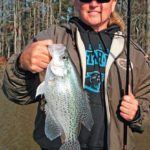
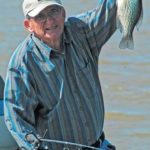
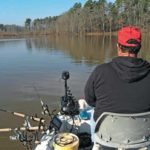
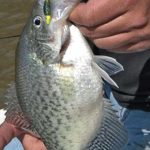
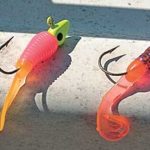
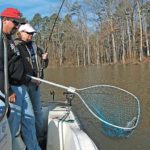
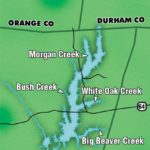



Be the first to comment